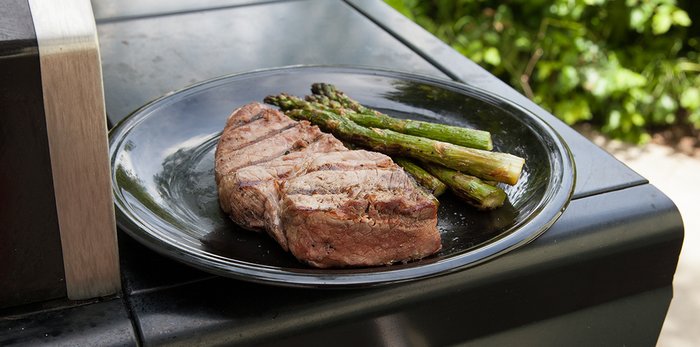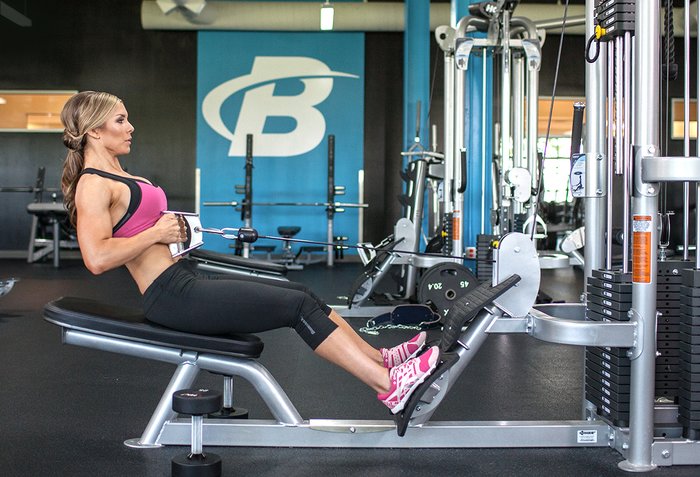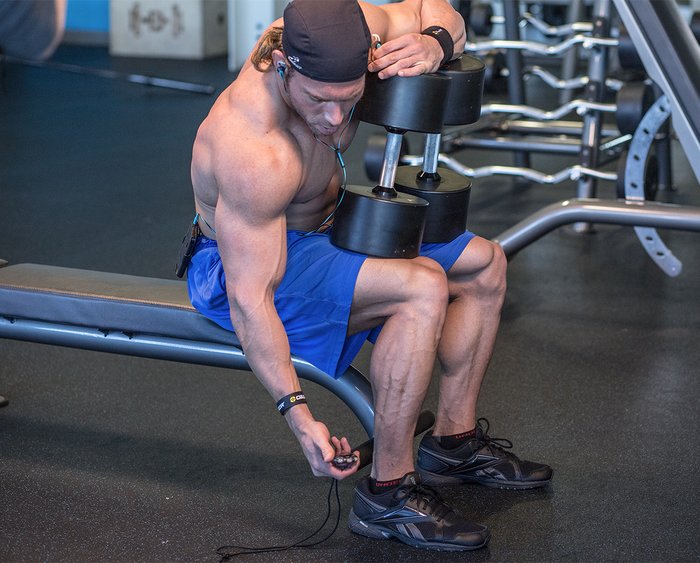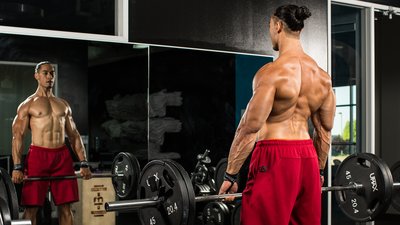What does it mean to be strong? Different people will have different definitions, based on different rep maxes, body weights, training styles—you name it. Other people will shout their maxes from the rooftops (or the YouTube comments section, which is the basement), but take a look at the lift itself and...you might go blind.
My own system doesn't involve max efforts. It's what I use as a guide to help clients set attainable benchmarks of strength for an able-bodied individual.
- Deadlift: 1.5 x body weight for 10 reps
- Chin-up: 10 strict reps with body weight
- Squat: Body weight equivalent for 10 reps
- Strict press: 3/4 of body weight for 3 reps
As you can probably see, these numbers aren't anything to call the Olympic Committee about. They simply allow a lifter to hold his or her own in the weight room, build some foundational musculature and a solid physique, and be able to set the stage for whatever they want to do next. If you want the science behind it, well, there isn't any. It's just what has worked for me as a trainer, and for my clients.
So, what will it take for you to get there? Here are my top rules, learned in the trenches, to ensure you're doing what you should to get your strength up—and just as important, not get in your own way. If you're not doing any of these, you should start, right now.
1. Eat Enough, Eat Right, And Gain Weight
When you're training for a specific goal, you'll almost always have to sacrifice another goal at the same time to some degree. If you want size, you might give up some mobility, at least in the short term. If you're charging after athletic conditioning, your bulk will probably deflate slightly. When it comes to training for greater max strength, you can bet your conditioning will take a hit. It's just how it goes.
If you're a long way from those benchmarks above, and you're planning on being able to keep those xylophone abs while scoring PRs right and left, you're probably dreaming—and not eating enough. Building strength is hard, and when you're chasing it, you need to consume adequate amounts of protein for muscle recovery and growth—and adequate calories, period.

Building strength is hard, and when you're chasing it, you need to consume adequate amounts of protein for muscle recovery and growth—and adequate calories, period.
In other words, it's OK to get heavier as the weights get heavier. A little more surface area is a good thing! You'll increase your muscle mass, and subsequently, your strength. Worry about cutting away any extra fat you gained once you've got more muscle to work with.
I'm not going to tell you what to eat; that part is up to you. But I'm not necessarily giving you permission to batter-dip your body on the way to a deadlift PR, either. If you do, your chin-up numbers will let you know when things have gotten out of hand!
2. Strength Train One Big Lift Per Workout
You're in the gym and feeling good today, but your self-designed workout has you challenging a new 3-rep max for overhead presses, deadlifts and bench press—all within a single hour-long training session.
What's the problem? Your nervous system only has a certain number of max-effort lifts it can generate in a short period of time. But CNS fatigue doesn't manifest itself as a strong burn or "hitting the wall" the way muscles fatigue when they're tired. Instead, it takes the form of weaker max lifts, weak recovery, and declining results. You can call it "overtraining" or whatever you want, but the real takeaway is that it's a recipe for getting weaker, not stronger.

There's a time and place for a test day to see where you're at with, say, the overhead press and deadlift. But don't confuse a test day with a training day; the two are entirely different animals.
Of course there's a time and place for a test day to see where you're at with, say, the overhead press and deadlift. But don't confuse a test day with a training day; the two are entirely different animals.
On a training day, going hard with one big lift will leave the other two hanging out to dry once you get to them, and you'll have a subpar workout that doesn't provide a strong-enough strength-building stimulus. A superior alternative would be to choose one big, heavy lift per workout, and train the other movements for higher rep ranges—especially if they're big lifts, too. That's the kind of smart periodization that turns intermediate lifters into advanced ones.
3. Pull More Than You Push
You've probably heard strength coaches giving this advice online before, usually while railing on your bad posture and jacked-up shoulders. But if you've been ignoring it, it's time to wise up. Pulling strength really does matter more than pushing strength. Hear me out.
Pressing exercises of both the upper- and lower-body varieties depend on healthy, functional joints to bear heavy loads in an effective, pain-free way through the full range of motion. (In other words, pain shouldn't be considered normal!) And those joints—particularly sensitive ones like the shoulders and hips—depend on having balanced musculature on both the anterior (front) and posterior (back) of the body.

A good example is the bench press. A strong bench press relies on healthy shoulders and strong, stable rotator cuffs, the muscles of which originate on the scapula. Strengthening the upper back through row and reverse-fly variations can actually improve bench-press strength, even if it means your overall bench-press volume goes down.
The same goes with glute- and hamstring-dominant "hinge" movements like deadlifts and RDLs. They're lower-body "pulls," and you'll need both if you want to squat as strong as possible while staying ahead of knee and hip issues.
4. Track Your Progress And Follow A Program
By now you're probably asking, "Lee, so what's the perfect workout already?" There isn't one, for the simple reason that you don't need a perfect program to get to those strength benchmarks. A good one will do, and Bodybuilding.com is full of programs that are up to the task. It doesn't have to be complicated, either; simple program structures can work just fine. Just be sure to follow the program and track your progress.
The tracking part is more important than you're probably giving it credit for. Aside from simply being more organized—because strength likes organization—it can also create a psychological benefit of knowing what you're capable of, making your goal for any particular day more realistic.
Get into the heat of training, and you'll quickly discover that structure is more important when you're going after strength than it is with size. When your objective in a workout is to exhaust certain muscles, there are many ways you can go about it. Strength is pickier. Systematic progression is a must.
5. Don't Obsess Over The Little Stuff
While structured programs, Internet articles, and YouTube videos can provide a wealth of valuable information, they can be a double-edged sword. Remember what I said earlier: Strength training attacks the nervous system, and it's up to you to keep it from overworking it.
So this is the point where I tell you to get out your stopwatch and make sure you rest at least 3 minutes between sets, right? Sure—if that feels right to you. You definitely want every single rep of loaded work to be of the highest quality you can manage. But honestly, the recommended rest period of your program may not be exactly what you need.

You need more rest in general when you're training for strength than for size. But there's nothing wrong with determining the length of your own rest intervals and going into your next heavy pull or press when you're ready to do so.
This is really about a larger issue, one that I discussed at length in my article, "What You Can Learn from An Old Gym Rat." Basically, some lifters stick like glue to the fine details of their program, even if it ends up limiting their true lifting potential in a given workout.
So yeah, you need more rest in general when you're training for strength than for size. But there's nothing wrong with determining the length of your own rest intervals and going into your next heavy pull or press when you're ready to do so. Of course, there are limits to this as well. It benefits no one to wait 15 minutes and get stone cold between sets.
Be Wise And Lift Big
Make sure the basics of your program, diet, and mentality are on point now, at the start of your strength journey. Don't let this stuff sneak up you; take control and design an approach as strong as the body you're trying to build. Happy trails!

